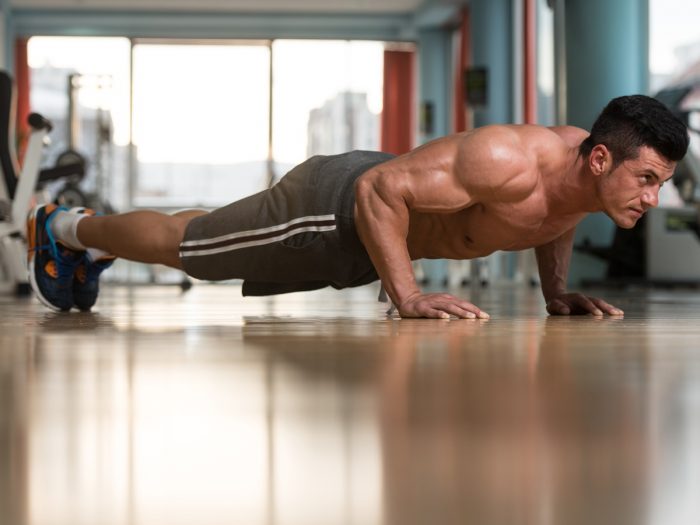As one of the most common and popular calisthenic exercises, push-ups are an excellent way to strengthen and shape numerous parts of your body at the same time. At their most basic, a push-up is an exercise that raises your body from a prone position on the ground to an elevated position using the strength of your arms.
These globally popular exercises are used everywhere from schools as a measure of base athletic ability to an endurance activity in military academies. As with other calisthenic activities, push-ups rely on the weight of the body to provide the resistance that makes the workout difficult. Before you make push-ups a daily part of your health, it is important to understand the proper form, and which type of push-up may be best for your goals and physical ability. [1]
Benefits of Push-ups
Push-ups have a huge range of benefits, including positive effects on your core, deltoids, pectorals, triceps, forearms, biceps and your calorie-burning, among others.
Core Strength
Push-ups are excellent for shaping the abdominal muscles and improving muscles of the lower back, which will increase support and balance in your body. [2]
Deltoids
Your deltoids are attached at the front, side, and rear of your shoulders, and are important supplemental muscles to the performance of a push-up. More deltoid strength can increase flexibility and strength in your upper arms. [3]
Pectorals
If you want to build your chest muscles, nothing is better than push-ups, as the chest muscles do most of the work in this exercise. This helps women and can elevate their bust and counter the strain of their breasts on chest muscles. [4]
Triceps, Biceps, & Forearms
Three different arm muscles are engaged in push-ups, and while they are not directly targeted with this exercise, they can still reap the benefits of increased strength. [5]
Calorie Burning
Push-ups burn a lot of calories because you are engaging multiple muscle groups at the same time. Studies have found that by engaging more muscle groups simultaneously, your fat and calorie-burning can increase significantly. [6]

Pushups are beneficial for building upper body strength. Photo Credit: Shutterstock
How to do the Perfect Push-ups?
As mentioned above, there are many push-up variations, but a perfect push-up should look something like this.
- Begin in a plank position, with your hands below your shoulders and slightly outside the frame of your body. You should form a straight line between your heels and your head.
- Slowly lower yourself down, letting your elbows kick back and allowing your chest to graze the ground. Your groin should not touch the ground, nor should your buttocks be up in the air.
- Press yourself slowly back to the initial plank position, exhaling as you go, and maintaining a flat line between the heels and head the entire time. Go slowly to ensure your form is maintained throughout.
- Repeat this exercise 15-20 times or as many as you can do without compromising your form.
Push-up Types
Some of the most popular push-up types include the windmill push-up, clap push-up, decline/incline push-up and diamond push-up, among many others.
Windmill Push-up
While performing a normal push-up, raise your right arm as you push back up, turning your torso in that direction to maintain balance. Alternate the arms you raise above your head with each rep.
Diamond Push-up
This is similar to a normal push-up, but you form a diamond with your two thumbs and index fingers. It demands far more balance and can be a more intense exercise for your core and back muscles. [7]
Clap Push-up
After every normal push-up you must clap your hands and then catch yourself before hitting the ground. This high-impact variety of push-ups increases the weight resistance of the workout, making it more effective for reducing calories. [8]
Decline/Incline Push-up
By inclining your feet behind you, or elevating your hands slightly, you can focus the effects of a push-up to the shoulder and upper chest, or the lower and middle chest, respectively. [9]
Push-ups for Beginners
If you are just starting out and want to get your body in shape, but are lacking in upper-body strength, try some push-ups for beginners. They include incline push-ups and knee push-ups.
Incline Push-ups
To begin with, you can lean against something with a higher incline, such as a counter or a desk. This will minimize the amount of weight you must push-up directly but can help to work out arm muscles and get you ready for full-fledged push-ups.
Knee Push-ups
Take a normal push-up position, but lower your knees to the ground for additional support. Then, lower and raise yourself with your arms, keeping your back as flat as possible.
Which Muscles do Push-ups Work Out?
When you work out your muscles, you are primarily working out your chest muscles (pectorals), deltoids (side, front and rear of your shoulder), abdominal muscles, triceps, biceps, forearms and lower back.
